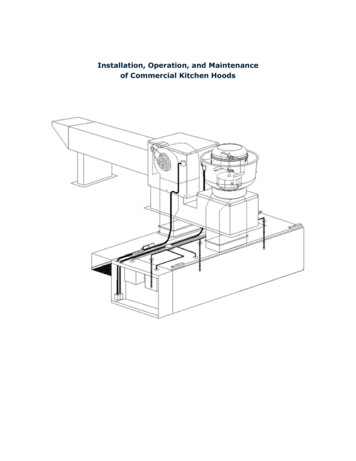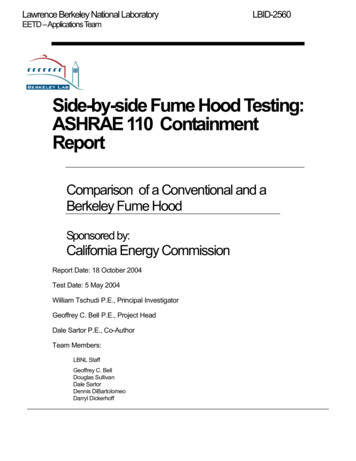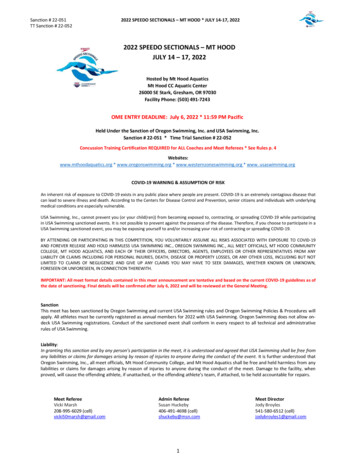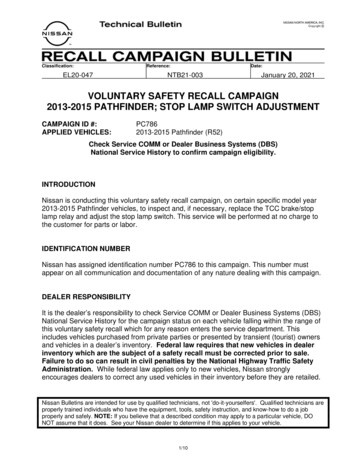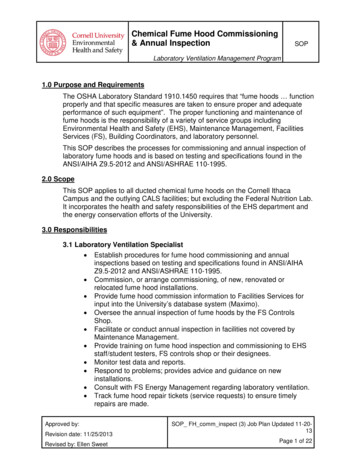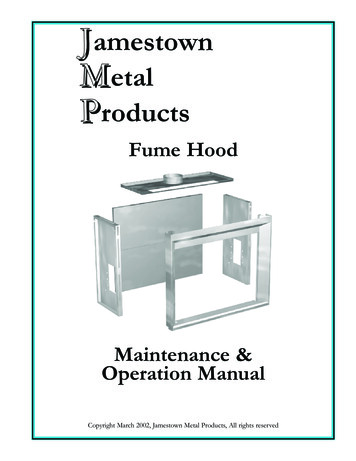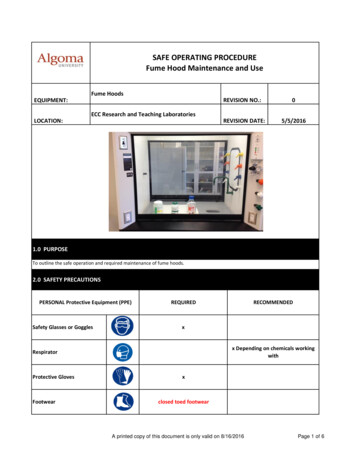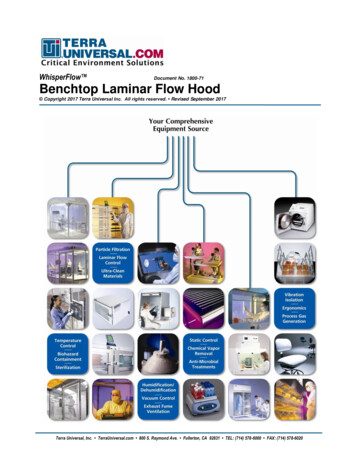
Transcription
HOODCHEMICALSAFETY DATA SHEETSDS00512DOWTHERM 4000Preparation Date: 28/Sep/2020Version: 11. IDENTIFICATIONProduct identifierProduct NameDOWTHERM 4000Other means of identificationSDS NumberSDS00512SynonymsNoneRecommended use of the chemical and restrictions on useRecommended UseHeat transfer fluids For non-evaporative closed loop systems. Do not use if thereis the possibility of incidental contact to food and/or potable water.Restricted UsesNo information availableInitial Supplier IdentifierHood Chemical.295 Alliance Rd. #14Milton, On. L9T 4W8Telephone: 1-800-567-9791Emergency telephone number24 Hour Emergency Phone Number (CANUTEC): 1-888-226-8832 (1-888-CAN-UTEC)2. HAZARD IDENTIFICATIONHazardous Classification of the substance or mixtureAcute toxicity - OralReproductive toxicitySpecific target organ toxicity (single exposure)Specific target organ toxicity (repeated exposure)Category 4Category 1BCategory 1 Category 3Category 2Label elementsHazard pictogramsEnglish / WHMIS2015Page 1 / 13
SDS00512 - DOWTHERM 4000Preparation Date: 28/Sep/2020Signal Word: DangerHazard statementsHarmful if swallowedMay damage fertility or the unborn childCauses damage to organsMay cause damage to organs through prolonged or repeated exposureMay cause respiratory irritationPrecautionary StatementsPreventionObtain special instructions before useDo not handle until all safety precautions have been read and understoodDo not breathe dust/fume/gas/mist/vapors/sprayWash face, hands and any exposed skin thoroughly after handlingDo not eat, drink or smoke when using this productWear protective gloves/protective clothing/eye protection/face protectionResponseIF exposed or concerned: Get medical advice/attentionIF SWALLOWED: Call a POISON CENTER or doctor if you feel unwellRinse mouthDo NOT induce vomitingStorageStore locked upDisposalDispose of contents/container to an approved waste disposal plant3. COMPOSITION/INFORMATION ON INGREDIENTSSubstanceNot applicable.MixtureChemical NameEthylene GlycolWaterDipotassium phosphatePotassium MetaborateCAS No107-21-17732-18-57758-11-413709-94-9Weight-% (W/W)80-1001-51-50.1-1SynonymsEthylene GlycolWaterDipotassium phosphatePotassium MetaborateEnglish / WHMIS2015Page 2 / 13
SDS00512 - DOWTHERM 4000Preparation Date: 28/Sep/2020Notes:The actual percentage concentration has been withheld as a trade secret.4. FIRST-AID MEASURESDescription of first aid measuresGeneral adviceShow this safety data sheet to the doctor in attendance. First Aid responders should pay attention to self-protectionand use the recommended protective clothing (chemical resistant gloves, splash protection).InhalationRemove to fresh air if effects occur. Consult a physician.Eye contactFlush eyes thoroughly with water for several minutes. Remove contact lenses after the initial 1-2 minutes andcontinue flushing for several additional minutes. Get medical attention if symptoms occur.Skin contactWash off immediately with soap and plenty of water while removing all contaminated clothes and shoes. Washcontaminated clothing before reuse. Discard contaminated leather articles such as shoes and belt. Get medicalattention if symptoms occur.IngestionDo NOT induce vomiting. Clean mouth with water and drink afterwards plenty of water. Never give anything by mouthto an unconscious person. Call a physician.Most important symptoms and effects, both acute and delayed:Corneal injury is unlikely. Repeated skin exposure to large quantities may result in absorption of harmful amounts.Massive contact with damaged skin or if material sufficiently hot to burn skin may result in absorption of potentiallethal amounts. Vapors or mists may cause eye irritation. May cause slight eye irritation Prolonged contact may causeskin irritation with local redness. At room temperature, vapors are minimal due to low vapor pressure. If material isheated or mist is produced, concentrations may be attained that are sufficient to cause irritation and other effects.Prolonged skin contact is unlikely to result in absorption of harmful amounts. Repeated contact may cause skinirritation with local redness. Brief contact is essentially non-irritating to skin. Harmful if swallowedIndication of any immediate medical attention and special treatment needed:Note to physiciansIt is estimated that the oral dose to adults is of the order of 1.0 ml/kg. Ethylene glycol is metabolized by alcoholdehydrogenate to various metabolites including glyceraldehydes, glycolic acid and oxalic acid which cause anelevated anion-gap metabolic acidosis and renal tubular injury. The signs and symptoms in ethylene glycol poisoningare those of metabolic acidosis, CNS depression and kidney injury. Urinalysis may show albuminuria, hematuria andoxaluria. Clinical chemistry may reveal anion-gap metabolic acidosis and uremia. The currently recommendedmedical management of ethylene glycol poisoning includes elimination of ethylene glycol and metabolites, correctionof metabolic acidosis and prevention of kidney injury. It is essential to have immediate and follow up urinalysis andclinical chemistry. There should be particular emphasis on acid-base balance and renal function tests. A continuousinfusion of 5% sodium bicarbonate with frequent monitoring of electrolytes and fluid balance is used to achievecorrection of metabolic acidosis and forced diuresis. As a competitive substrate for alcohol dehydrogenase, ethanol isantidotal. Given in the early stages of intoxication, it blocks the formulation of nephrotoxic metabolites. Atherapeutically effective blood concentration of ethanol is in the range 100 - 150 mg/dl and should be achieved by arapid loading dose and maintained by intravenous infusion. For severe and /or deteriorating cases, hemodialysis maybe required. Dialysis should be considered for patients who are symptomatic, have severe metabolic acidosis, a bloodEnglish / WHMIS2015Page 3 / 13
SDS00512 - DOWTHERM 4000Preparation Date: 28/Sep/2020ethylene glycol concentration greater than 25 mg/dl, or compromise of renal functions.A more effective intravenous antidote for physician use in 4-methylpyrazole, a potent inhibitor of alcoholdehydrogenases which effectively blocks the formation of toxic metabolites of ethylene glycol. It has been used todecrease the metabolic consequences of ethylene glycol poisoning before metabolic acidosis coma, seizures andrenal failure have occurred. A generally recommended protocol is a loading dose of 15 mg/kg followed by 10 mg/kgevery 12 hours for 4 doses and the 15 mg/kg every 12 hours until the ethylene glycol concentrations are below 20mg/100ml.Slow intravenous infusion is required. Since 4-methylpyrazole is dialyzable, increased dosage may benecessary during hemodialysis. Additional therapeutic measures may include the administration of cofactors involvedin the metabolism of ethylene glycol. Thiamine (100 mg) and pyridoxine (50 mg) should be given every six hours.Pulmonary edema with hypoxemia has been described in a number of patients following poisoning with ethyleneglycol. The mechanism of production has not been elucidated, but it appears to be non-cardiogenic in origin inseveral cases. Respiratory support with mechanical ventilation and positive end expiratory pressure may berequired. There may be cranial nerve involvement in the late stages of toxicity from swallowed ethylene glycol. Inparticular, effects have been reported involving the seventh, eighth and ninth cranial nerves, presenting with bilateralfacial paralysis, diminished hearing, and dysphagia. Treatment should be directed at preventing absorption,administering to symptoms as they occur, and providing supportive therapy.5. FIRE-FIGHTING MEASURESSuitable Extinguishing MediaWater fog or fine spray, carbon dioxide, dry chemical, foam. Alcohol resistant foams (ATC type) are preferred ifavailable. General purpose synthetic foams (including AFFF) or protein foams may function, but much lesseffectively. Do not use direct water stream, which will spread fire.Specific hazards arising from the substance or mixtureUse water spray to cool fire-exposed containers and structures. Isolate and restrict area access. Move containersfrom fire area if you can do it without risk. Violent steam generation or eruption may occur upon application of directwater stream to hot liquids. Container may rupture from gas generation in a fire situation. Withdraw immediately incase of rising sound from venting safety devices or discoloration of tank. Liquid mist of this product can burn.Flammable concentrations of vapor can accumulate at temperatures above flash point.Hazardous combustion productsDecomposition products can include and are not limited to:. Alcohols. Ethers. Aldehydes. Carbon monoxide. Carbondioxide.Special protective equipment and precautions for fire-fightersFirefighters should wear self-contained breathing apparatus and full firefighting turnout gear. Use personal protectionequipment.6. ACCIDENTAL RELEASE MEASURESPersonal precautions, protective equipment and emergency proceduresEnsure adequate ventilation. Keep people away from and upwind of spill/leak. Wash thoroughly after handling. Usepersonal protective equipment as required.Environmental precautionsPrevent from entering into soil, ditches, sewers, waterways and/or groundwater. Consult local authorities.Methods and materials for containment and cleaning upEnglish / WHMIS2015Page 4 / 13
SDS00512 - DOWTHERM 4000Preparation Date: 28/Sep/2020Small spills: soak up with absorbent material and scoop into containers. Large spills : prevent contamination ofwaterways. Dike and pump into suitable containers. Clean up residual with absorbent material, place in appropriatecontainer and flush with water.7. HANDLING AND STORAGEPrecautions for safe handlingFor industrial use only. Handle and open containers with care. Avoid contact with eyes, skin and clothing. Do notingest. Avoid inhalation of chemical. Empty containers may contain hazardous product residues. Keep thecontainers closed when not in use. Protect against physical damage. Use appropriate personnel protectiveequipment. Spills of these organic materials on hot fibrous insulations may lead to lowering of the autoignitiontemperature possibly resulting in spontaneous combustion.Conditions for safe storage, including any incompatibilitiesKeep containers tightly closed in a dry, cool and well-ventilated place. Keep out of the reach of children. Do not storein galvanized steel. Do not store in unlabeled containers. Store in original container. Store in carbon steel, stainlesssteel. Shelf life 60 months.8. EXPOSURE CONTROLS/PERSONAL PROTECTIONControl parametersExposure Limits.Chemical NameAlberta OELBritish ColumbiaOELEthylene Glycol107-21-1Ceiling: 100mg/m3TWA: 10 mg/m3 CEV: 100 mg/m3STEL: 20 mg/m3Ceiling: 100mg/m3Ceiling: 50 ppmNot availableNot availableWaterNot available7732-18-5DipotassiumNot availableNot availablephosphate7758-11-4PotassiumNot availableTWA: 2 mg/m3MetaborateSTEL: 6 mg/m313709-94-9Consult local authorities for recommended exposure limitsOntarioQuebec OELExposure Limit ImmediatelyACGIHDangerous to Lifeor Health - IDLHCeiling: 50 ppm50 ppm STELNot availableCeiling: 12710 mg/m3 STELmg/m325 ppm TLV-TWANot availableNot availableNot availableNot availableNot availableNot availableNot availableNot availableNot available6 mg/m3 STEL2 mg/m3TLV-TWANot availableAppropriate engineering controlsEngineering controlsProvide general and/or local exhaust ventilation to control airborne levels below the exposure guidelines.Individual protection measures, such as personal protective equipmentEye/face protectionChemical goggles; also wear a face shield if splashing hazard exists.English / WHMIS2015Page 5 / 13
SDS00512 - DOWTHERM 4000Preparation Date: 28/Sep/2020Hand protectionAppropriate chemical resistant gloves should be worn. Use gloves chemically resistant to this material, examples ofpreferred glove barrier materials include:. Natural rubber gloves. Neoprene gloves. Nitrile rubber. Ethyl Vinyl AlcoholLaminate (EVAL). Polyethylene gloves. Polyvinyl alcohol (PVA). NOTICE: The selection of a specific glove for aparticular application and duration of use in a workplace should also take into account all relevant workplace factorssuch as, but not limited to: Other chemicals which may be handled, physical requirements (cut/puncture protection,dexterity, thermal protection), potential body reactions to glove materials as well as the instructions/specificationsprovided by the glove supplier.Skin and body protectionSkin contact should be prevented through the use of suitable protective clothing, gloves and footwear, selected forconditions of use and exposure potential. Consideration must be given both to durability as well as permeationresistance.Respiratory protectionIf exposure exceeds occupational exposure limits, use an appropriate NIOSH-approved respirator. Organic vaporcartridge with a particulate pre-filter.General hygiene considerationsHandle in accordance with good industrial hygiene and safety practice.9. PHYSICAL AND CHEMICAL PROPERTIESInformation on basic physical and chemical propertiesAppearancePhysical stateLiquidColorOrangeOdorCharacteristicOdor thresholdNo information availablePROPERTIESValuespH9.5Melting point / freezing point-25 C / -13 FInitial boiling point/boiling range 148 C / 298 FFlash point127 C / 261 FEvaporation rate 0.5Flammability (solid, gas)No data availableFlammability Limit in AirUpper flammability limit:No data availableLower flammability limit:No data availableVapor pressure2.0 mmHg @ 20 CRelative vapor density 1Specific Gravity1.1-1.15Water solubilityCompletely miscibleSolubility in other solventsNo data availablePartition coefficientNo data availableAutoignition temperature427 C / 801 FDecomposition temperatureNo data availableKinematic viscosity12.2 cSt at 20 CDynamic viscosityNo data availableExplosive propertiesNo information available.Oxidizing propertiesNo information available.Remarks MethodPensky-Martens Closed Cup ASTM D93None known(Ethylene Glycol)None knownNone knownNone knownEnglish / WHMIS2015Page 6 / 13
SDS00512 - DOWTHERM 4000Preparation Date: 28/Sep/2020Molecular weightVOC Percentage VolatilityLiquid DensityBulk densityNo information availableNo information availableNo information availableNo information available10. STABILITY AND REACTIVITYReactivity/Chemical StabilityStable under normal conditionsPossibility of hazardous reactionsNo additional remark.Hazardous polymerizationWill not occur.Conditions to avoidProduct can decompose at elevated temperatures. Generation of gas during decomposition can cause pressure inclosed systems.Incompatible materialsStrong oxidizers. Strong acids. Strong bases.Hazardous decomposition productsDecomposition products can include and are not limited to:. Alcohols. Ethers. Aldehydes.11. TOXICOLOGICAL INFORMATIONInformation on likely routes of exposureInhalationMay cause irritation of respiratory tract. At room temperature, vapors are minimal due to low vapor pressure. Ifmaterial is heated or mist is produced, concentrations may be attained that are sufficient to cause irritation and othereffects.Eye contactCorneal injury is unlikely. Vapors or mists may cause eye irritation. May cause slight eye irritation.Skin contactRepeated skin exposure to large quantities may result in absorption of harmful amounts. Massive contact withdamaged skin or if material sufficiently hot to burn skin may result in absorption of potential lethal amounts. Prolongedcontact may cause skin irritation with local redness. Prolonged skin contact is unlikely to result in absorption ofharmful amounts. Repeated contact may cause skin irritation with local redness. Brief contact is essentiallynon-irritating to skin.IngestionHarmful if swallowed.Information on toxicological effectsSymptomsRepeated inhalation of ethylene glycol may produce signs of central nervous system involvement, particularlydizziness and nystagmus (involuntary eye movement). Exposure may place individuals with existing heart problems atadded risk of potential cardiac irregularities and heart failure. In animals , effects have been reported on the followingEnglish / WHMIS2015Page 7 / 13
SDS00512 - DOWTHERM 4000Preparation Date: 28/Sep/2020organs: Kidney, liver.Numerical measures of toxicityAcute toxicityThe following values are calculated based on chapter 3.1 of the GHS documentATEmix (oral)532.00 mg/kgUnknown acute toxicityChemical NameEthylene Glycol107-21-1Water7732-18-5Dipotassium phosphate7758-11-4Potassium Metaborate13709-94-9.No information availableOral LD50 4700 mg/kg ( Rat )Inhalation LC50Not available 90 mL/kg ( Rat )Dermal LD50 10600 mg/kg ( Rat ) 9530µL/kg ( Rabbit )Not availableNot availableNot availableNot availableNot availableNot availableNot availableNot availableDelayed and immediate effects as well as chronic effects from short and long-term exposureSkin corrosion/irritationBrief contact is essentially non-irritating to skin. Repeated contact may cause skin irritation with local redness.Prolonged contact may cause skin irritation with local redness.Serious eye damage/eye irritationCorneal injury is unlikely. Vapors or mists may cause eye irritation. May cause slight eye irritation.Respiratory or skin sensitizationBased on available data, the classification criteria are not met. Based on information for component(s): Did not causeallergic skin reactions when tested in guinea pigs.Germ cell mutagenicityNo information available.CarcinogenicityBased on available data, the classification criteria are not met.Chemical NameEthylene Glycol107-21-1Water7732-18-5Dipotassium phosphate7758-11-4Potassium Metaborate13709-94-9ACGIHNot availableIARCNot availableNTPNot availableOSHANot availableNot availableNot availableNot availableNot availableNot availableNot availableNot availableNot availableNot availableNot availableNot availableNot availableReproductive toxicityEthylene glycol has been shown to produce dose-related teratogenic effects in rats and mice when given by gavageor in drinking water at high concentrations or doses. The no-effect doses for developmental toxicity for ethyleneglycol given by gavage over the period of organogenesis has been shown to be 150 mg/kg/day for the mouse and500 mg/kg/day for the rat. Also, in a preliminary study to assess the effects of exposure of pregnant rats and mice toaerosols at concentrations of 150, 1000 and 2500 mg/m3 for 6 hours a day throughout the period of organogenesis,teratogenic effects were produced at the highest concentration, but only in mice. The conditions of these latterexperiments did not allow a conclusion as to whether the developmental toxicity was mediated by inhalation ofEnglish / WHMIS2015Page 8 / 13
SDS00512 - DOWTHERM 4000Preparation Date: 28/Sep/2020aerosol, percutaneous absorption of ethylene glycol from contaminated skin, or swallowing of ethylene glycol as aresult of grooming the wetted coat. In a further study, comparing effects from high aerosol concentration bywhole-body or nose-only exposure, it was shown that nose-only exposure resulted in maternal toxicity (1000 and 2500mg/m3) and developmental toxicity with minimal evidence of teratogenicity (2500 mg/m 3). The no-effectsconcentration (based on maternal toxicity) was 500 mg/m3. In a further study in mice, no teratogenic effects could beproduced when ethylene glycol was applied to the skin of pregnant mice over the period of organogenesis. Theabove observations suggest that ethylene glycol is to be regarded as an animal teratogen. There is currently noavailable information to suggest that ethylene glycol has caused birth defects in humans. Cutaneous application ofethylene glycol is ineffective in producing developmental toxicity. Exposure to high aerosol concentrations is onlyminimally effective in producing developmental toxicity.Specific target organ systemic toxicity - single exposureCentral Nervous System. Kidneys. May cause respiratory irritation.Specific target organ systemic toxicity - repeated exposureCauses damage to organs through prolonged or repeated exposure if swallowed. For the majorcomponent(s):Observations in humans include: Nystagmus (involuntary eye movement). In animals, effects havebeen reported on the following organs:. Kidney. Liver.Aspiration hazardNo information available.12. ECOLOGICAL INFORMATIONEcotoxicity.Chemical NameEthylene Glycol107-21-1Water7732-18-5Dipotassium phosphate7758-11-4Potassium Metaborate13709-94-9Ecotoxicity - Freshwater Ecotoxicity - Fish SpeciesAlgae DataData6500 - 13000 mg/L EC5014 - 18 mL/L LC50Pseudokirchneriella(Oncorhynchus mykiss)subcapitata 96 h96 h static 40000 - 60000mg/L LC50 (Pimephalespromelas) 96 h static16000 mg/L LC50(Poecilia reticulata) 96 hstatic 27540 mg/L LC50(Lepomis macrochirus)96 h static 40761 mg/LLC50 (Oncorhynchusmykiss) 96 h static 41000mg/L LC50(Oncorhynchus mykiss)96 hNot availableNot availableToxicity tomicroorganismsNot availableCrustaceaEC50: 46300mg/L (48h,Daphnia magna)Not availableNot availableNot availableNot availableNot availableNot availableNot availableNot availableNot availableNot availablePersistence and degradabilityNo information available.BioaccumulationNo information available.Component InformationChemical NamePartition coefficientEnglish / WHMIS2015Page 9 / 13
SDS00512 - DOWTHERM 4000Preparation Date: 28/Sep/2020Ethylene Glycol107-21-1Water7732-18-5Dipotassium phosphate7758-11-4Potassium Metaborate13709-94-9Other adverse effects-1.93Not availableNot availableNot availableNo information available.13. DISPOSAL CONSIDERATIONSWaste treatment methodsDispose of in accordance with local regulations. Dispose of waste in accordance with environmental legislation.Do not reuse empty containers.14. TRANSPORT INFORMATIONTDG (Canada):UN NumberShipping nameClassPacking GroupMarine pollutantNot applicableNot regulatedNot applicableNot applicableNot available.DOT (U.S.)UN NumberShipping nameClassPacking GroupMarine pollutantNot applicableNot regulatedNot applicableNot applicableNot available15. REGULATORY INFORMATIONSafety, health and environmental regulations/legislation specific for the substance or mixtureU.S. Regulatory RulesChemical NameEthylene Glycol - 107-21-1Water - 7732-18-5Dipotassium phosphate 7758-11-4Potassium Metaborate 13709-94-9International InventoriesTSCADSL/NDSLCERCLA/SARA - Section 302: SARA (311, 312) Hazard Class: CERCLA/SARA - Section 313:Not ListedListedListedNot ListedNot ListedNot ListedNot ListedNot ListedNot ListedNot ListedNot ListedNot ListedAll components of this product are either on the Toxic Substances Control Act(TSCA) Inventory List or exempt.All components of this product are either on the Domestic Substances List (DSL),English / WHMIS2015Page 10 / 13
SDS00512 - DOWTHERM 4000Preparation Date: 28/Sep/2020the Non-Domestic Substances List (NDSL) or exempt.Legend:TSCA - United States Toxic Substances Control Act Section 8(b) InventoryDSL/NDSL - Canadian Domestic Substances List/Non-Domestic Substances List16. OTHER INFORMATIONNFPA:Health hazards 1Flammability 1HMIS:Health hazards 2Flammability 1Instability 0Physical andchemical propertiesPhysical hazards 0 Personal protectionXLegend Section 8: EXPOSURE CONTROLS/PERSONAL PROTECTIONTWATWA (time-weighted average)STELSTEL (Short Term Exposure Limit)*Skin designationCeilingMaximum limit valuePrepared By:The Environment, Health and Safety Department of Univar Canada Ltd.Preparation Date:Revision Date:28/Sep/202028/Sep/2020DisclaimerNOTICE TO READER:Univar expressly disclaims all express or implied warranties of merchantability and fitness for a particularpurpose, with respect to the product or information provided herein, and shall under no circumstances beliable for incidental or consequential damages.Do not use ingredient information and/or ingredient percentages in this SDS as a product specification. Forproduct specification information refer to a Product Specification Sheet and/or a Certificate of Analysis.These can be obtained from your local Univar Sales Office.All information appearing herein is based upon data obtained from the manufacturer and/or recognizedtechnical sources. While the information is believed to be accurate, Univar makes no representations as to itsaccuracy or sufficiency. Conditions of use are beyond Univar's control and therefore users are responsible toverify this data under their own operating conditions to determine whether the product is suitable for theirparticular purposes and they assume all risks of their use, handling, and disposal of the product, or from thepublication or use of, or reliance upon, information contained herein. This information relates only to theproduct designated herein, and does not relate to its use in combination with any other material or in anyother process. 2015 Univar Inc. All rights reserved. Univar, the hexagon, the Univar logo and MasterLine are the registeredtrademarks of Univar Inc.End of Safety Data SheetRegionTemplatenameHGHSThe followingsections havebeen revised:Revision Note 2.0CanadaEnglish / WHMIS2015Page 11 / 13
SDS00512 - DOWTHERM 4000Preparation Date: 28/Sep/2020Inhalation StatementInhalationLiquid or AerosolAt room temperature, vapors are minimal due to low vapor pressure. If material is heated or mist isproduced, concentrations may be attained that are sufficient to cause irritation and other effects.None anticipated Avoid contact with metals such as: zinc, magnesium, aluminum and galvanizedmetals.No additional remark.Persons with pre-existing eye, skin, respiratory tract, kidney or liver disorders may be more susceptibleto the effects of this product.Symptoms of poisoning may even occur after several hours; therefore medical observation for at least48 hours after the accident. Treatment should be directed at preventing absorption, administering tosymptoms as they occur, and providing supportive therapy.Extinguish fires with water spray or apply alcohol-type or all-purpose-type foam by manufacturer'srecommended techniques for large fires.Fixed equipment as well as transfer containers and equipment should be grounded to preventaccumulation of static charge. For industrial use only. Handle and open containers with care. Avoidcontact with eyes, skin and clothing. Do not ingest. Avoid inhalation of chemical. Empty containers maycontain hazardous product residues. Keep the containers closed when not in use. Protect againstphysical damage. Use appropriate personnel protective equipment.Keep containers tightly closed in a dry, cool and well-ventilated place Keep out of the reach of childrenIn the laboratory environment, this product should be handled in a hood.Apron, coveralls and/or other resistant protective clothing.Appropriate chemical resistant gloves should be worn.If exposure exceeds occupational exposure limits, use an appropriate NIOSH-approved respirator. ANIOSH approved air purifying respirator with organic vapor cartridges and particulate prefilter.Conditions to avoidPossibility of hazardous reactionsSymptomsNote to physiciansSuitable Extinguishing MediaAdvice on safe handlingStorage ConditionsEngineering controlsSkin and body protectionHand protectionRespiratory protectionpHKinematic viscosity - VALUE 1Physical stateFlash point C - VALUE 1Boiling point / boiling range C VALUE 19.512.2 cSt at 20 CLiquid127148Flash Point:&126.7&260.06&&&GHS ClassificationPrecautionary StatementsSignal Word:Acute toxicity - OralHazard statementsSignal wordReproductive toxicitySpecific target organ toxicity (singleexposure)Specific target organ toxicity (repeatedexposure)Acute toxicity - OralComponentExclude thisnon-hazardouschemical fromtoxicity andecotoxicitycalculations forLD/LC/EC50Ethylene Glycol107-21-1 ( 80-100 )Water7732-18-5 ( 1-5 )Dipotassium phosphate 7758-11-4 ( 1-5 )P264 - Wash face, hands and any exposed skin thoroughly after handling P270 - Do not eat, drink orsmoke when using this product P301 P312 - IF SWALLOWED: Call a POISON CENTER or doctor ifyou feel unwell P330 - Rinse mouth P501 - Dispose of contents/ container to an approved wastedisposal plantDangerCategory 4Harmful if swallowedWarningCategory 1BCategory 1 Category 3Category 2- (H302)mg/kg oral LD50 LD50 (Dermal,(rat)Rat, mg/kg)Inhalation LC50 - Inhalation LC50 - Inhalation LC50 - Inhalation LC50 4 hour - dust/mist4 hour - gas 4 hour - vapor - 4 hour - vapor - mg/Lppmmg/Lmg/L------------------English / WHMIS2015Page 12 / 13
SDS00512 - DOWTHERM 4000Preparation Date: 28/Sep/2020Potassium Metaborate13709-94-9 ( 0.1-1 )Graphic-Hazard statementsHazard statementsPrecautionary StatementsPrecautionary alThe following values are calculated basedon chapter 3.1 of the GHS documentATEmix (oral)UnitsUnitsUnknown acute toxicityUnknown Acute Aquatic ToxicityUnknown Chronic Aquatic ToxicityProduct ATE Oral StatusProduct ATE Dermal StatusProduct ATE Inhalation - Gas StatusProduct ATE Inhalation - Vapor StatusProduct ATE Inhalation - Dust/Mist StatusProduct Skin Corrosion StatusProduct Eye Damage StatusProduct Respiratory Sens. StatusProduct Skin Sensitization StatusProduct Mutagenic StatusProduct Carcinogenic StatusProduct Reproductive Toxicity StatusProduct STOT Single StatusProduct STOT Repeated StatusProduct Aquatic Toxicity StatusProduct Aspiration Toxicity StatusProduct Ozone StatusProduct and Component OverallClassification StatusUnknown acute toxicity------Harmful if swallowed May damage fertility or the unborn child Causes damage to organs May causedamage to organs through prolonged or repeated exposure May cause respiratory irritationH302 - Harmful if swallowed H303 - May be harmful if swallowedDo not eat, drink or smoke when using this product IF SWALLOWED: Call a POISON CENTER ordoctor if you feel unwell Call a POISON CENTER or doctor Call a POISON CENTER or doctor if youfeel unwell IF SWALLOWED: Call a POISON CENTER or doctor if you feel unwell Rinse mouthP264 - Wash face, hands and an
SDS00512 - DOWTHERM 4000 _ Preparation Date: 28/Sep/2020 _ English / WHMIS2015 Page 5 / 13 Small spills: soak up with absorbent material and scoop into containers. Large spills : prevent contamination of waterways. Dike and pump into suitable containers. Clean up residual with absorbent material, place in appropriate .
